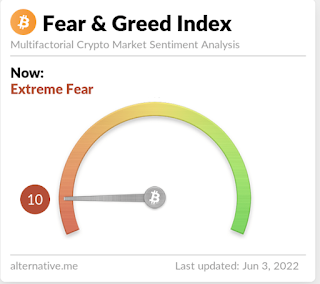With so much hype of bull markets (greed) and bear markets (fear), it can be very helpful to understand the context of crypto markets with an indicator. For example, with Bitcoin at $29,700 is it a bull market or bear market? If it was January 2021, with it being an all time high, you would say bull market. But if it is June 2022, where it has been constantly going down from a high of $63,000 you would say it is a bear market. Below are 2 types of indicators that can help provide more context.
1. Crypto Fear & Greed Index
The Crypto Fear & Greed Index tries to quantify current emotional sentiment of Bitcoin and Crypto markets into a number between 0 and 100. With 0 being Extreme Fear and 100 represents Extreme Greed. Currently, we are near extreme fear. In the above example with Bitcoin at $29,700 it was 88 in January 2021 and currently in June 2022 it is 10.
The index is composed of multiple factors (25% Volatility, 25% Market Momentum/Volume, 15% Social Media, 15% Surveys, 10% Dominance, 10% Google Trends). More info can be found here:
https://alternative.me/crypto/fear-and-greed-index/
2. Implied Volatility Indexes
- Bitcoin Volatility Index -BVIN - https://www.cryptocompare.com/indices/bvin/
This index is created similar to the CBOE VIX using a Variance calculation for 30 day options, but uses Deribit as it's options source.
- BitVol (Bitcoin Volatility) and EthVol (Ethereum Volatility) - https://t3index.com/indices/bit-vol/
Applying the same calculations we did with VIX, for Bitcoin with a Volatility of 73%, we can use that to infer the below expected moves.
Takeaways
By taking a quick glance at the Crypto Fear & Greed index you can get an idea of the emotional sentiment around Bitcoin and other crypto currencies. Further by looking at the volatility indexes you can get an idea of how much the market expects crypto to move going forward. In summary, the Crypto Fear & Greed Index provides 1 number that takes into account all past information and the Volatility Indexes take into account market expectations giving you a full picture of the crypto market with just 2 numbers.
Related Posts -
https://www.unpackinvesting.com/2022/05/how-can-you-use-cboe-volatility-index.html




Comments
Post a Comment